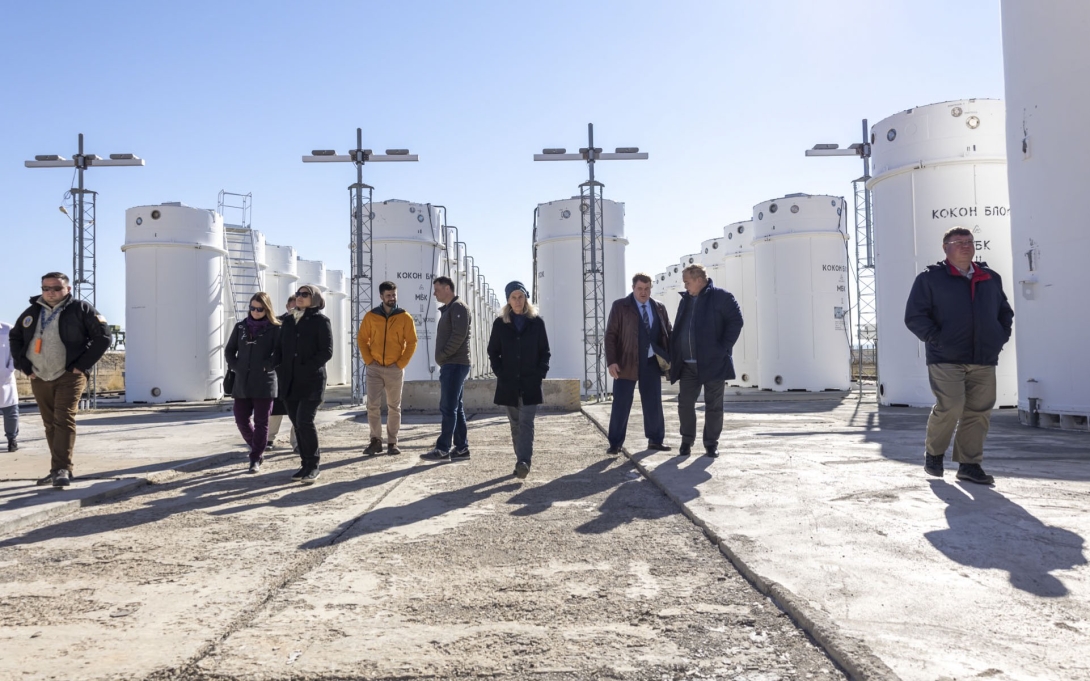The National Nuclear Security Administration’s budget increased by $1.5 billion to $22.2 billion for fiscal year 2023, with most of the additional money allocated to plutonium infrastructure projects. Congress also provided significant budget increases for inertial confinement fusion and nuclear nonproliferation.
Congress raised the National Nuclear Security Administration’s budget by 7% to $22.2 billion for fiscal year 2023, almost twice the increase the Biden administration requested. About $1 billion of the increase is for reconstituting the capability to manufacture new plutonium cores for use in the U.S. nuclear arsenal.
In addition, Congress increased the budget for NNSA’s Stockpile, Research, Technology, and Engineering portfolio by 3% to just over $3 billion, rejecting the administration’s request to pare it back 3%. It also raised NNSA’s Defense Nuclear Nonproliferation budget by 6% to $2.49 billion, whereas the administration requested a level budget.
Detailed policy direction for NNSA is included in an explanatory statement accompanying the appropriations legislation and a report prepared by House appropriators. Summary figures are collected in FYI’s Federal Science Budget Tracker.
Plutonium pit production
To replace aging plutonium cores, which are known as pits, Congress has directed NNSA to establish the capability to produce 80 pits per year by 2030, though the agency has said it will be unable to meet that deadline.
NNSA’s current plans are to produce 30 pits per year at Los Alamos National Lab and 50 pits per year at its Savannah River Site. Congress ramped up the annual budget of the Los Alamos project by nearly 30% to $1.55 billion for fiscal year 2023, slightly below the request, and it more than doubled the annual budget of the Savannah River project to $1.26 billion, exceeding the request by $500 million.
Although Congress has strongly supported the pit production projects, House appropriators registered concern that the budget demands of warhead production and refurbishment have “placed significant downward pressure on other critical activities,” including NNSA’s science programs. “Continuing this unbalanced funding strategy is not sustainable, and the administration is strongly encouraged to appropriately value the role of science and technology in sustaining the stockpile without the need for [explosive] testing,” they added.
Stockpile Research, Technology, and Engineering
Inertial confinement fusion. Congress increased NNSA’s ICF budget by $50 million to $630 million, rejecting the requested $36 million cut. The appropriation set minimum funding levels for the three main facilities supported by the ICF program: $380 million for the National Ignition Facility at Lawrence Livermore National Lab, a $30 million increase over last year’s minimum; $83 million for the Z Pulsed Power Facility at Sandia National Labs, a $16 million increase; and $86 million for the OMEGA Laser Facility at the University of Rochester, a $3 million increase.
Congress did not specify how much NNSA should contribute to the Nike Laser at the Naval Research Lab, which the administration proposed to zero out. An NNSA spokesperson indicated the agency is providing $4.5 million to the Naval Research Lab for ICF-related activities in fiscal year 2023, down from the $6 million minimum Congress specified for the previous fiscal year.
NNSA is also directed to promptly produce a plan for “recapitalizing, upgrading, and maintaining ICF facilities,” which Congress first requested last year. NNSA observed in its request that these facilities have “urgent needs for refurbishment” and pledged to make a “significant investment” over the next five years to “sustain the ICF facilities and assure their continued contributions to stockpile stewardship in the 2030s.” A study just released by the National Academies also makes the case for “extending, upgrading, or replacing” these facilities.
Shortly before Congress finalized its appropriations legislation in December, the ICF program achieved a historic success when NIF met its namesake goal of fusion ignition, wherein the implosion of a fuel capsule yielded more energy than the laser energy applied to it. Although the energy output was only about 1% of the energy drawn from the electric grid to fire the lasers, the result has energized political interest in the facility and fusion power.
Engineering R&D. Congress raised the Engineering and Integrated Assessments program budget by $47 million to $389 million, about double the requested increase. Within this total, Congress matched the requested $34 million increase to the Weapons Survivability program, which works to ensure warheads will continue to function in hostile conditions. The money will support conceptual design work on a facility called Combined Radiation Environments for Survivability Testing (CREST), which will enable study of how nuclear weapons will function under stresses such as electromagnetic pulses and neutron radiation. NNSA anticipates CREST’s total cost will be $2.1 billion.
Congress also provided a $14 million increase to the recently created Stockpile Responsiveness Program, which provides scientists and engineers with opportunities to exercise design and production skills that are not used in the maintenance-focused activities of stockpile stewardship. House and Senate appropriators both initially proposed to slash the program’s budget from $50 million to $10 million, whereas the administration sought to restore the program to near its fiscal year 2021 budget of $70 million. Appropriators did not explain their initial proposals, though direction in the House report presses NNSA to provide Congress more timely updates about the program’s activities.
NNSA stated in its budget request that the program’s highest priority is to “examine alternative approaches to design, manufacturing, certification, and qualification to accelerate the timeline for the nuclear weapons lifecycle and reduce costs.” Other program activities include analyzing “consequences of emerging threats,“ studying “challenge problems” such as “strategic deep underground target defeat,” and conducting non-nuclear flight tests that provide junior staff with “experience in the process of turning ideas into a working system.”
Plutonium imaging facility. Congress accepted the request to decrease the Assessment Science program budget by $50 million to $855 million, which is more than accounted for by a funding reduction requested for construction work on a project to enhance the U1a underground experimental complex at the Nevada National Security Site. To address gaps in physics understanding needed to certify future weapons, NNSA is upgrading the complex to host an X-ray machine called Scorpius that will enable “cinematographic” imaging of subcritical plutonium implosions. Future funding needs for the project are currently in flux as NNSA officials recently disclosed that its completion schedule could be delayed by at least three years in part due to supply chain issues caused by the pandemic, according to reporting by the news outlet Exchange Monitor.
Advanced computing. Congress increased the Advanced Simulation and Computing program budget by $43 million to $790 million, exceeding initial proposals by appropriators to hold the budget about flat as requested. NNSA is currently preparing to install its first exascale computer, El Capitan, at Lawrence Livermore National Lab this year.
Academic programs. Congress held the account funding university-based research and workforce development flat at $112 million, declining the administration’s request for a 10% cut. Within this amount, Congress directed NNSA to increase funding for a program supporting work at minority-serving institutions by $5 million to $45 million, continuing a string of recent increases, and it allocated level funding of $10 million for a program focused on Tribal Colleges and Universities.
Defense Nuclear Nonproliferation
Nonproliferation workforce development. In 201X, NNSA created the Nonproliferation Stewardship Program to foster the foundational technical capabilities and workforce needed to address emerging proliferation threats. Congress has rapidly ramped up its budget and provided a $25 million increase for fiscal year 2023, bringing it to $125 million, exceeding the $109 million requested. Congress also increased funding for the Nonproliferation and Arms Control program by 25% to $231 million, double the requested increase. Among NNSA’s planned activities are to continue developing a new nonproliferation training platform for the International Atomic Energy Agency and an “arms control user facility” that aims to accelerate the development of new monitoring and verification methods for arms control treaties.
Low-enriched uranium fuel. Congress provided level funding of $20 million for a program that is exploring alternatives to powering naval vessels with highly enriched uranium, which successive administrations have proposed to terminate. The U.S. Navy and DOE have argued that converting to low-enriched uranium fuel would be impractical and costly.
Biosecurity. Congress accepted the administration’s request for $20 million to launch a Bioassurance Program that will expand NNSA’s role in biodefense research in partnership with the Department of Energy’s Office of Science. NNSA stated in its request that the program will focus on “anticipating destabilizing biological threats, both naturally occurring and anthropogenic, and avoiding technical surprise through predictive modeling and data science.” It will also develop threat mitigation measures and safeguards analogous to those NNSA maintains for nuclear weapons.
FYI is an editorially independent science policy news service from the American Institute of Physics. If you are interested in republishing this content, please contact fyi@aip.org.



